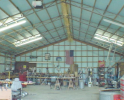I've been taught that an item is functionally obsolete when the cost to replace is more than its contributing value. Are there other reasons why an item can be functionally obsolete?
Just because it exhibits functional obsolescence does not mean it is worth zero. Shops are commonly very "functional" and unless in poor condition, generally contribute value of some sort.
So first you need to get some idea of the quality and cost of the building as well as its utility. And, of course, you need to find some comps to extract the contribution. So you find a sale with a similar barn/shop but say, different in size.
So the sale price is say $300,000
the land with site improvements & utilities is say $100,000
Net to Improvements is $200,000
The house usually exhibits the least obsolescence (functional) so say the house is 20 years old with 30 years remaining life. It is 40% gone. So you go to the cost book and find it is $150/SF (incl. 10% for Entrepreneurial profit) and the house is 2,000 SF so it is $300,000 RCN, and suffers $120,000 in physical deterioration. That leaves it at $180,000 remaining life. Thus the outbuilding contributes $20,000. Say the shop is 2000 SF too and thus contributes $10/SF. You can apply that $10 to any size shop of similar design.
Also keep those sales in file. It doesn't matter if the sale is nearby only in the same general market area, and time is not an issue. I generally keep such sales for no less than 3 years.
One other caveat is that there are light metal clad sheds with 2" light square tubing, there are pole in the ground barns, there are dirt and concrete floors, and there are high dollar red iron barns. "Black iron" also is a lighter metal frame usually with wood purlins whereas the red iron is usually all metal as are the really light frame - "coast to coast" sheds - which are very cheap comparatively speaking.

Red iron, all metal, not insulated

Black iron with wood purlins and insulation

Cheap canopy carport and same companies build enclosed sheds similar to this
Wood pole frame with floating concrete slab (inside was dirt)

So you need to try and estimate the quality type and condition
Does it have water? Does it have electricity? Does it have overhead doors and door openers? Is it dirt or wood frame? Poles, continuous footings, metal of one type or another? Insulated or not? Concrete floor or dirt? Use the cost book judiciously but local builder bids are better and you often see pricing in Farm magazines, rural electric co-op periodicals, and the local Shopper magazines.




